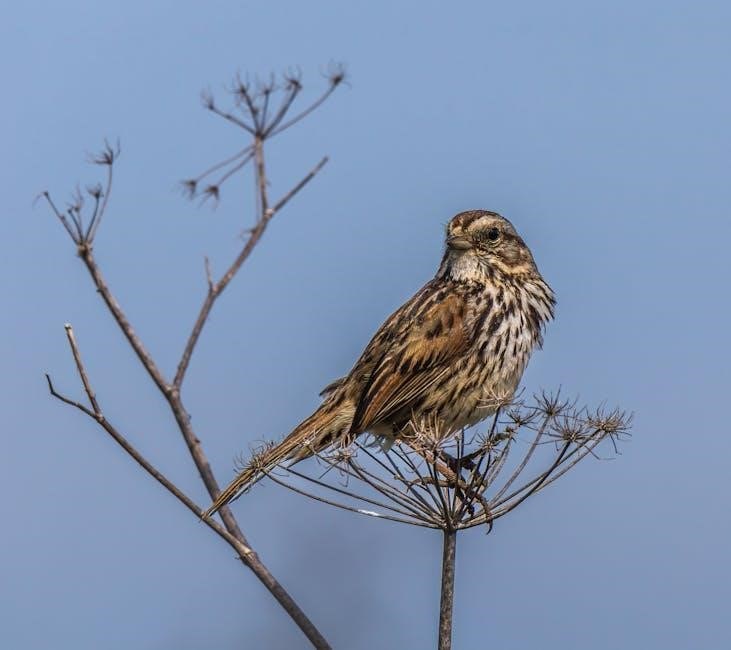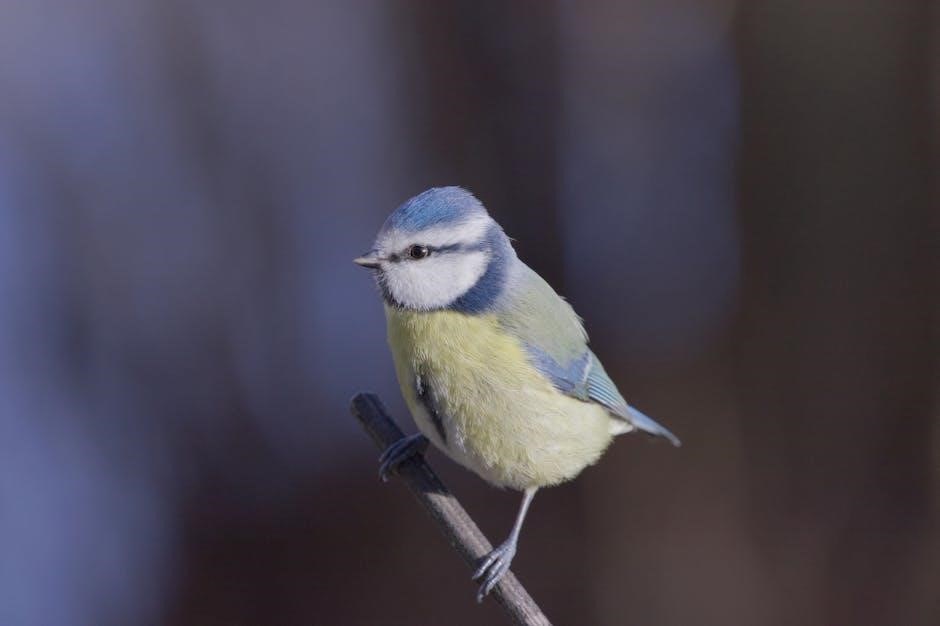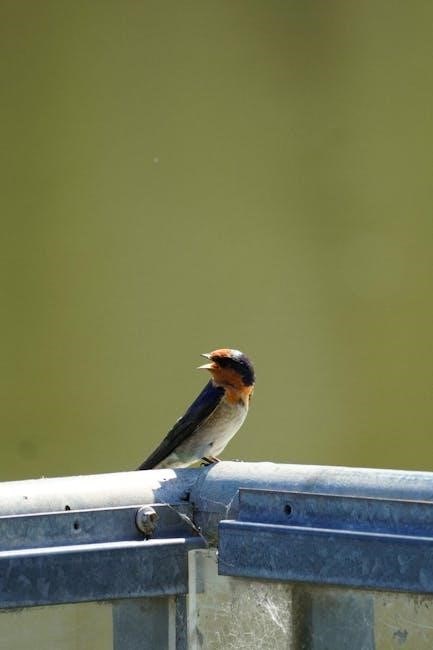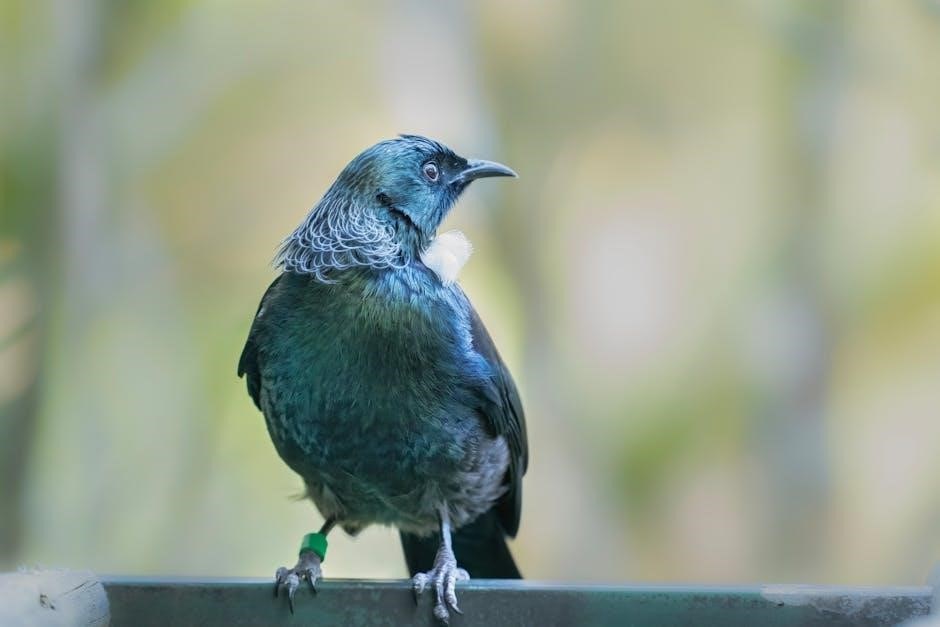Discover the enchanting world of backyard birdsong with comprehensive guides, featuring audio recordings and smartphone apps. Enhance your birding experience while supporting conservation efforts and fostering a deeper connection with nature.
Why Birdsong Matters
Birdsong plays a vital role in ecosystems, aiding species identification, mating, and territory defense. Recognizing birdsong enhances birdwatching experiences, fostering deeper connections with nature. Conservation efforts benefit from understanding birdsong, as it reflects environmental health and species behavior. By learning these vocalizations, enthusiasts can contribute to biodiversity monitoring and support avian populations. Birdsong also serves as a universal language, bridging human and wildlife interactions, making it an essential element of backyard birding adventures and ecological awareness.
Overview of Backyard Birdsong Guides
Backyard birdsong guides are essential tools for bird enthusiasts, offering detailed insights into bird vocalizations and species identification. These guides often include audio recordings, visual aids, and range maps to enhance learning. Popular guides like the Backyard Birdsong series cover eastern and western North America, featuring 75 species each. They combine scientifically accurate illustrations with built-in audio players or smartphone app integration, making bird identification accessible and engaging for both novices and experienced birders. These resources foster a deeper appreciation for avian life and conservation efforts.
Understanding Birdsong
Birdsong is a vital form of communication, used for mating, territory defense, and social interaction, enriching our connection with nature and wildlife.
The Science Behind Bird Vocalizations
Bird vocalizations are produced by the syrinx, located at the base of the trachea. This unique organ enables birds to create complex songs and calls; Research shows that birds learn songs through a combination of genetic predisposition and environmental influence. The brain plays a key role in song production, with specific regions dedicated to learning and replicating sounds. Birdsong serves essential functions, including territory defense, mate attraction, and social communication, making it a critical aspect of avian behavior and survival.
Common Types of Bird Calls and Songs
Bird vocalizations vary widely, ranging from simple calls to complex songs. Songs are often melodious and used for territory defense or attracting mates, while calls serve immediate communication needs, like alarms or contact. Common types include whistles, chirps, and trills, each unique to species. Recognizing these patterns helps in identification. Tools like mnemonics and smartphone apps, such as Merlin Bird ID, aid enthusiasts in distinguishing and memorizing these vocalizations, enhancing backyard birding experiences and deepening connections with nature.
Essential Gear for Birdsong Identification
Essential gear for birdsong identification includes binoculars for visual confirmation and smartphone apps like Merlin Bird ID for audio recognition, enhancing your backyard birding experience.
Binoculars for Visual Confirmation
Binoculars are a cornerstone of backyard birding, offering a closer look at feathered visitors. With magnification power and a wide field of view, they help confirm species identification. Image stability and clarity ensure detailed observations, while compact designs make them portable for backyard or garden use. Paired with birdsong recognition, binoculars enhance the overall birding experience, allowing enthusiasts to visually verify species after hearing their unique calls or songs.
Smartphone Apps for Birdsong Recognition
Smartphone apps like Merlin Bird ID and Audubon Bird Guide revolutionize backyard birdsong recognition. These tools offer instant identification through photo recognition and audio samples. Users can upload images or play recordings to match species. Built-in libraries of bird calls and songs enable learners to practice and refine their listening skills. Additionally, apps provide educational resources and tips for distinguishing similar species, making them indispensable companions for enhancing backyard birding experiences and improving birdsong knowledge effectively.

The Backyard Birdsong Guide: Eastern North America
Explore the vibrant birdlife of Eastern North America with interactive guides featuring 75 species, scientifically accurate illustrations, and built-in audio recordings of their unique songs and calls.
Key Species and Their Songs
Eastern North America is home to iconic birds like the American Robin, known for its cheerful whistled melody, and the House Wren, whose rapid, bubbly song fills backyards. The Northern Cardinal’s clear, whistled phrases are easily recognizable. These species, along with others like the Blue Jay and Red-winged Blackbird, create a vibrant soundscape. Guides provide detailed audio clips and visual aids, helping enthusiasts identify and appreciate the unique vocalizations of these birds, enhancing the joy of backyard birding experiences.
Seasonal Variations in Birdsong
Birdsong patterns vary significantly across seasons, influenced by breeding, migration, and environmental changes. Spring is the peak season for vibrant vocalizations, as males establish territories and attract mates. Summer sees a slight decline as birds focus on nesting. Autumn brings migratory species, introducing new sounds, while winter offers quieter, yet distinctive calls from year-round residents like cardinals and blue jays. Recognizing these seasonal shifts enhances backyard birding, offering a dynamic listening experience throughout the year.

The Backyard Birdsong Guide: Western North America

Explore the diverse vocalizations of Western North America’s birds with this guide, featuring 75 species, scientifically accurate illustrations, and range maps for enhanced identification and listening experiences.
Regional Differences in Bird Vocalizations
Western North America’s bird vocalizations vary significantly from those in the East, shaped by unique species and habitats. The region’s birds, such as the Western Meadowlark and Mountain Bluebird, produce distinct melodies. In contrast to Eastern birds, Western species often exhibit higher-pitched calls, reflecting their evolutionary adaptation to open landscapes and coniferous forests. These regional differences highlight the importance of tailored guides for accurate identification and a deeper appreciation of local biodiversity.

Using Audio Guides for Accurate Identification
Audio guides are indispensable tools for recognizing bird vocalizations. Built-in players with recordings from sources like the Cornell Lab enable quick comparison of songs. Apps such as Merlin Bird ID and Audubon Bird Guide offer real-time identification, enhancing accuracy. These resources simplify learning and distinguishing between similar species, making birding more accessible and enjoyable for enthusiasts of all skill levels.

Tips for Learning Birdsong
Dedicate time daily to listen and familiarize yourself with bird sounds. Use mnemonics or rhymes to remember specific calls. Practice with guided exercises to sharpen your skills.
Mnemonics and Rhymes for Remembering Songs
Mnemonics and rhymes are powerful tools for remembering bird songs. For example, the Black-capped Chickadee’s call resembles “Who cooks for you?” Associating sounds with phrases or rhythms helps in distinguishing species. Using these techniques, enthusiasts can create mental links between bird vocalizations and their identities. Regular practice with mnemonics enhances recognition skills, making backyard birding more enjoyable and enriching the connection with nature.
Practical Listening Exercises
Engage in daily listening sessions in your backyard or during walks. Use smartphone apps to verify identifications. Practice distinguishing between similar calls by focusing on pitch, rhythm, and tone. Start with common species and gradually explore rarer ones. Record and replay bird songs to enhance familiarity. Join local birding groups for collaborative learning. Vary your listening environments and times to broaden your exposure to diverse vocalizations. Patience and consistent practice will refine your birdsong recognition skills over time.

Conservation and Birdsong
Birdsong reflects environmental health, serving as an indicator of ecosystem balance. Conservation efforts protect habitats, ensuring diverse vocalizations thrive, while supporting local bird populations enhances backyard birding experiences.
How Birdsong Reflects Environmental Health
Birdsong serves as a vital indicator of environmental health, reflecting the balance and stability of ecosystems. Changes in song patterns, frequency, or complexity can signal habitat degradation or pollution. Healthy bird populations with diverse vocalizations often thrive in pristine environments, while declines in birdsong diversity may indicate broader ecological issues. By monitoring backyard birdsong, enthusiasts can contribute to conservation efforts, gaining insights into the well-being of local wildlife and the effectiveness of environmental stewardship practices.
Ways to Support Local Bird Populations
Creating a bird-friendly habitat is essential for supporting local bird populations. Plant native vegetation to provide food and shelter, install bird feeders and water sources, and set up nesting boxes for species like bluebirds or robins. Reducing pesticide use protects birds and insects alike. Engaging in community conservation efforts, such as tree-planting initiatives or bird counts, fosters a healthier environment. Educating others about birdsong and habitat preservation amplifies these efforts, ensuring a thriving ecosystem for future generations.
Interactive Tools and Resources
Interactive tools like Merlin Bird ID and Cornell’s audio guides offer comprehensive resources to identify birds by sound and sight, enriching your backyard birding experience.
Online Birdsong Libraries
Online birdsong libraries like the RSPB Bird Song Identifier and Cornell’s Macaulay Library provide extensive collections of bird vocalizations. These resources allow users to listen to and compare recordings of various species, aiding in accurate identification. Many libraries are searchable by region, season, and species, making them invaluable for backyard bird enthusiasts. Additionally, platforms like Merlin Bird ID integrate audio recognition, enabling users to identify birds by their songs instantly. These tools enhance learning and make birding more accessible and enjoyable for all skill levels.
Field Guides with Built-In Audio
Field guides with built-in audio revolutionize bird identification by combining detailed visuals with actual recordings. The Backyard Birdsongs series, featuring touch-button audio players, offers immersive learning. These guides cover 75 species with scientifically accurate illustrations and range maps. Perfect for novices and experts alike, they provide a hands-on approach to recognizing birds by their songs. Such tools bridge the gap between visual and auditory identification, making backyard birding more engaging and educational for enthusiasts of all levels.

Backyard Birding Hotspots
Transform your backyard into a birding hotspot by creating a bird-friendly habitat with native plants and water sources, attracting diverse species for optimal listening and observation.
Creating a Bird-Friendly Habitat
Transform your backyard into a haven for birds by planting native vegetation, installing water sources, and avoiding pesticides. Native plants attract diverse species, while water features like birdbaths or ponds provide essential resources. Incorporating nesting boxes and maintaining a chemical-free environment further supports local bird populations. By creating a welcoming habitat, you enhance both bird diversity and your listening experience, fostering a deeper connection with nature and its rhythms.
Optimal Times for Birdsong Listening
The best times to listen to birdsong are during the early morning and late afternoon when birds are most active. The morning chorus, typically between sunrise and mid-morning, is peak time for male birds to sing for mating and territorial defense. Seasonal variations also play a role, with spring being the prime season for vibrant songs; Weather conditions, such as clear, calm mornings, enhance sound clarity, making it ideal for enthusiasts to identify species like the Northern Cardinal or American Robin.
Embrace the joy of backyard birdsong by exploring guides, audio tools, and conservation tips. Foster a deeper connection with nature and enhance your birding adventures effortlessly.
Enhancing Your Backyard Birding Experience
Combine knowledge of birdsong with visual identification for a richer birding experience. Use mnemonics and rhymes to remember songs, and explore smartphone apps like Merlin Bird ID for quick recognition. Create a bird-friendly habitat with native plants and water sources to attract diverse species. Engage with online communities and field guides to deepen your understanding. By fostering a welcoming environment and leveraging modern tools, you can transform your backyard into a vibrant birding sanctuary, enhancing both conservation efforts and personal enjoyment.
